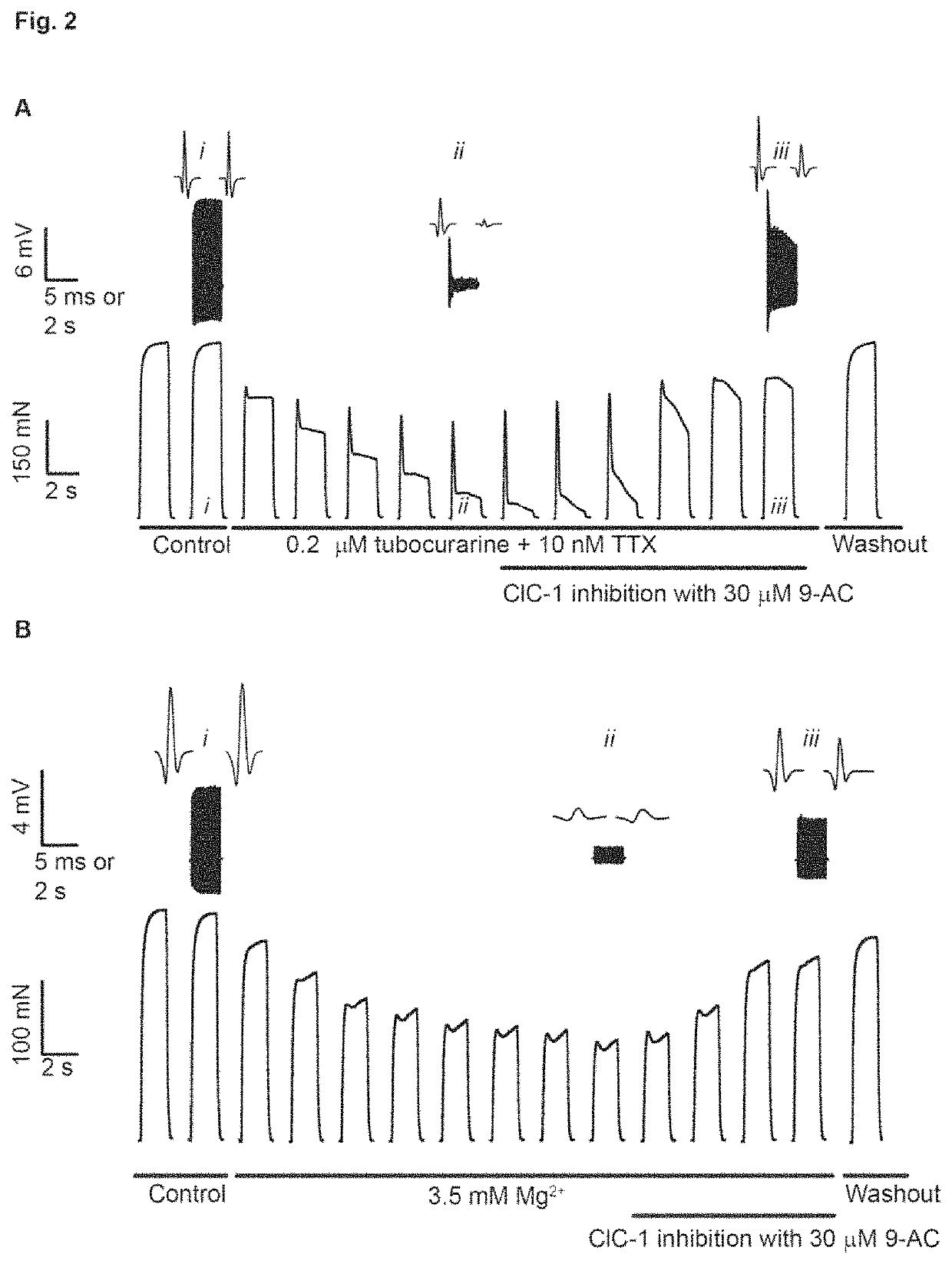Compounds for use in treating neuromuscular disorders
a neuromuscular disorder and compound technology, applied in the field of compound for treating neuromuscular disorders, can solve the problems of insufficient epps to trigger muscle fiber action potentials, marked reduction of current flow generated by ach receptor activation, gastric discomfort, etc., and achieve the effect of reducing nerve-stimulated force and nerve-stimulated for
- Summary
- Abstract
- Description
- Claims
- Application Information
AI Technical Summary
Problems solved by technology
Method used
Image
Examples
example 1
Experimental Approach for Testing Compounds
[0756]The aim was to find compounds that by inhibition of ClC-1 channels can recover nerve-stimulated force under conditions of fatigue including conditions where fatigue is caused by compromised neuromuscular transmission. Neuromuscular transmission dysfunction can develop because of both pre- and / or post-synaptic complications in connection with a disorder or as part of neuromuscular blockade during / after surgery. In the initial series of drug testing, experiments were performed with isolated muscles in the presence of sub-maximal ACh receptor antagonist tubocurarine. Since the inclusion of tubocurarine caused a partial loss of neuromuscular transmission this experiment mimics the conditions in myasthenia gravis3,5 and neuromuscular blockade25. To mimic conditions with pre-synaptic complication (Lambert Eaton syndrome2, motor neuron disorder11, 12, polyneuropathy19) the intact nerve-muscle preparations were incubated at elevated extracell...
example 2
Proof-of-Concept that ClC-1 Inhibition Can Overcome Loss of Neuromuscular Transmission in Conditions Mimicking Neuromuscular Disorders
[0758]To initially confirm that inhibition of ClC-1 ion channels can be used to recover contractile force in muscle with reduced neuromuscular transmission, isolated nerve-muscle preparations were first exposed to either tubocurarine (FIG. 2A) or elevated Mg2+ (FIG. 2B) and then a specific ClC-1 inhibitor (9-AC) was added. It can be seen that ClC-1 inhibition caused a marked recovery of both force and M-wave signal in both conditions. This demonstrates the novel concept that ClC-1 channel inhibition can alleviate loss of force induced by compromised neuromuscular transmission. Similar observations were seen in EDL and diaphragm muscles from both young and adult rats (data not shown). 9-AC does not have the potential to be used as a pharmaceutical.
example 3
Identification of Useful Compounds for Improving Neuromuscular Transmission
[0759]To identify ClC-1 inhibitors that could be used for treatment of neuromuscular disorders we repeated the experiment shown in FIG. 2A but instead of adding 9-AC we added the compounds of interest in different concentrations within the range from 10 to 500 μM. The starting point for finding ClC-1 inhibitors was derivatives of clofibrate that have been shown to have ClC-1 inhibiting actions33 (Table 1). FIG. 3A shows representative nerve-stimulated force in two muscles during such an experiment before and during exposure to tubocurarine. In one of the muscles (black trace), 50 μM of a test compound (C8) was added after 40 mins in tubocurarine. For comparison with the muscle only exposed to tubocurarine (grey trace), the two traces have been overlaid. It can be seen that while tubocurarine affected the two muscles equally before C8 addition (middle traces), the muscle receiving C8 recovered markedly when co...
PUM
| Property | Measurement | Unit |
|---|---|---|
| body weight | aaaaa | aaaaa |
| body weight | aaaaa | aaaaa |
| body weight | aaaaa | aaaaa |
Abstract
Description
Claims
Application Information
 Login to View More
Login to View More - R&D Engineer
- R&D Manager
- IP Professional
- Industry Leading Data Capabilities
- Powerful AI technology
- Patent DNA Extraction
Browse by: Latest US Patents, China's latest patents, Technical Efficacy Thesaurus, Application Domain, Technology Topic, Popular Technical Reports.
© 2024 PatSnap. All rights reserved.Legal|Privacy policy|Modern Slavery Act Transparency Statement|Sitemap|About US| Contact US: help@patsnap.com










